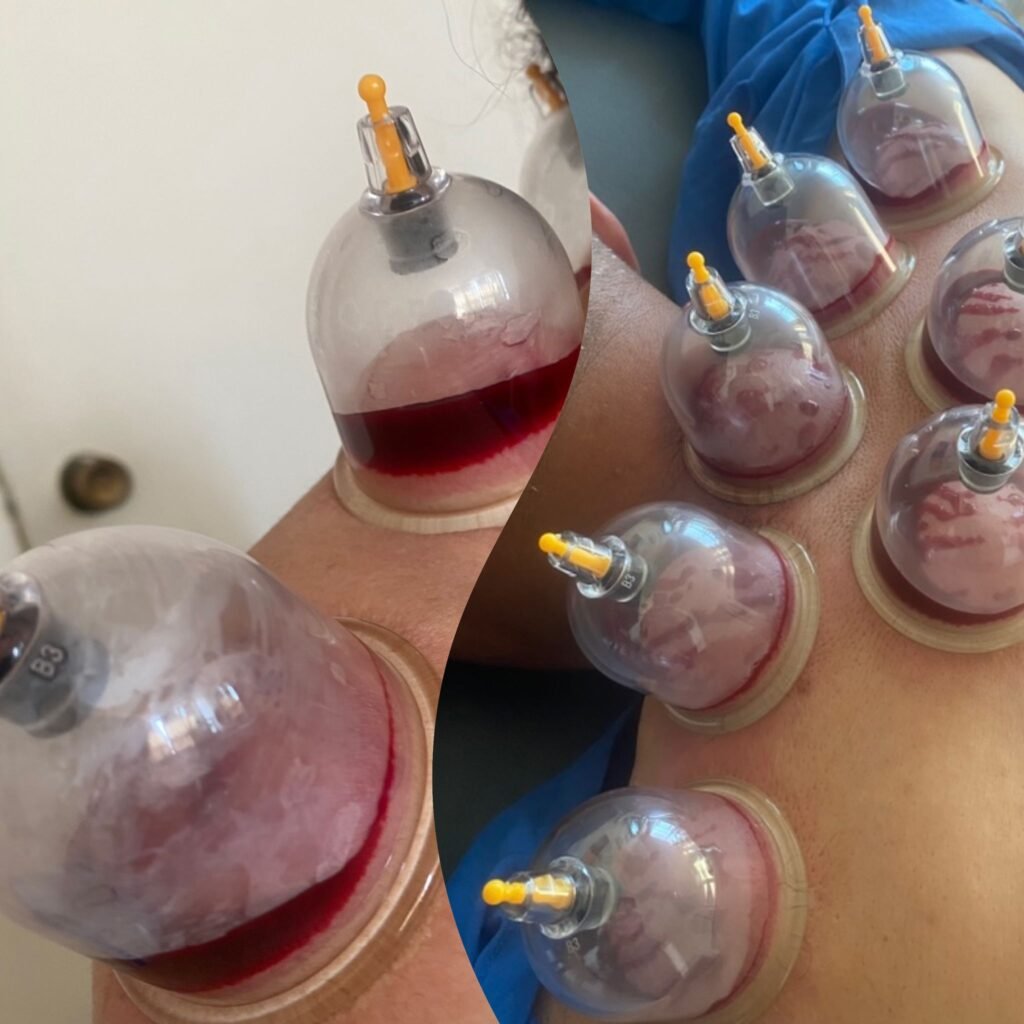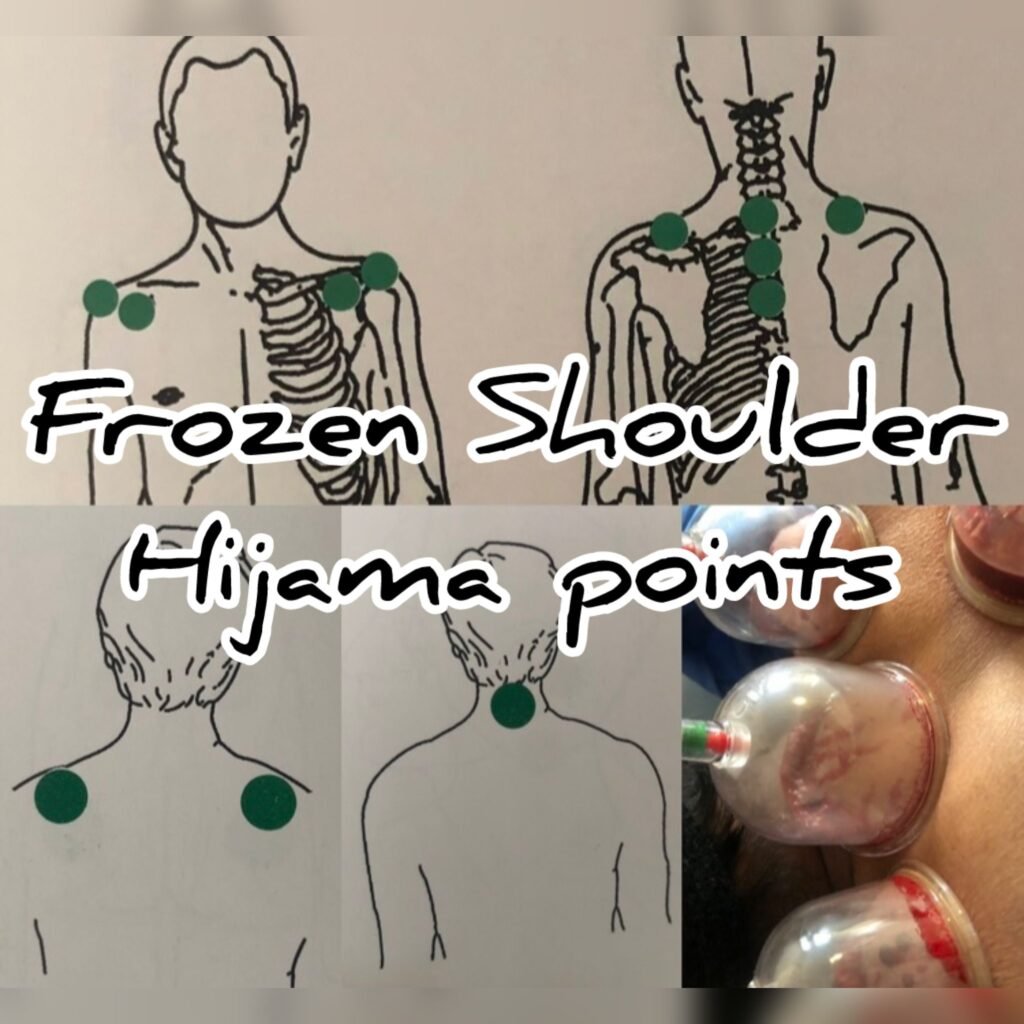No products in the cart.
Frozen Shoulder & Hijama Cupping Therapy
Hijama cupping therapy plays a complementary role in the treatment of the frozen shoulder.

Frozen shoulder is also called adhesive capsulitis. It is a very painful condition in which you can’t move your shoulder freely. Pain and stiffness develop in the shoulder joint which becomes worse slowly. Mostly it takes one to three years to recover from a frozen shoulder.
Our shoulder is made up of three bones.
- The upper arm ( humerus)
- Shoulder blade ( scapula)
- Collar bone (clavicle)
Besides bones tissues are also attached to shoulder joints, known as shoulder capsules. The shoulder capsule becomes so stiff and thick that gives the shoulder a difficult time making a slight move.
Risk Factors & causes of Frozen Shoulder
1- Frozen shoulder mostly happens in women than men.
2- Women get frozen shoulder between the age of 40 to 60.
3- Some medical issues are associated with frozen shoulders like thyroid, Cardiac diseases, Parkinson’s disease.
4- Immobilization of the shoulder can lead to a frozen shoulder, for instance, after an arm injury.
5- Inflammation of the muscles or tendons can be a risk factor for a frozen shoulder.
6- When the connective tissues become tightened or thickened around the shoulder joint, it ends up as a result of a frozen shoulder.
7- Frozen shoulder often occurs in people with diabetes.
How Frozen Shoulder Happens
The connective tissues that hold the shoulder joints together are called shoulder capsules. Normally these capsules tend to expand and contract as the arm moves to different positions. But when the capsule has become inflamed thickened and scarred, the movement of the shoulder becomes restricted and whenever you move your joint it becomes very painful. So the inflammation of a capsule makes it a frozen shoulder. The exact reason for the frozen shoulder is still unknown but a few of the causes are mentioned above.
Symptoms
The important symptoms of a frozen shoulder are pain and stiffness. Mostly it develops slowly and it takes a couple of years to recover. Shoulder pain becomes worse at night, which makes it hard to sleep. The pain is usually located over the outer area of the shoulder and sometimes the upper arm.
The symptoms of a frozen shoulder are categorized into three phases. Each phase has its different symptoms and different timelines.
- The freezing phase: The shoulder becomes extremely stiff and very painful to move. It gets worse over time and mostly hurts at night. The stage lasts from 6 to 9 months.
- The frozen phase: In this phase, pain starts to diminish slowly but the shoulder becomes stiffer which makes it more difficult to move. In this phase, an individual is unable to fulfill his daily routine activities. the stage lasts from 4 to 12 months.
- The recovery(thawing) phase: In this phase, an individual feels less pain and the ability to move the shoulder improves. The range of motion starts coming back to normal. This stage lasts 6 months to 2 years.
How to Treat Frozen Shoulder
The frozen shoulder gets better over time, although it may take months to years for complete recovery. The main goal should be to increase the motion and decrease the pain. There are several methods to decrease pain.
For temporary pain relief, over-the-counter painkillers may be taken. There are several exercises, yoga poses, meditation, relaxation techniques and several physical therapies like Hijama cupping therapy, massage therapy or acupuncture are there for pain relief. Some of the treatments or home remedies are as under:
1- Heat packs or ice packs should be applied to the affected shoulder.
2- An individual with this issue should not stay in a colder atmosphere for longer. They should wear warm clothes to cover the affected area.

Some exercises are the best to recover frozen shoulder.
3- Some of the exercises that are best to recover soon from a frozen shoulder just like the pendulum stretch, armpit stretch or towel stretch, finger walk and cross-body reach.
4- A warm bath always helps to decrease the level of pain and stiffness.
5- Pain gets unbearable at night so it is very important to create a comfort zone before sleeping for example mattress should be extra soft and try to put extra cushions all around you.
6- Avoid holding heavyweight luggage.
7- Ginger oil massage is best the treatment for frozen shoulders.
8- Turmeric has anti-inflammatory properties so applying turmeric paste on the affected shoulder can also help to recover.

9- Ginger tea is the best anti-inflammatory agent so try to take a cup every day.

10- One teaspoon of Apple cider vinegar in a warm glass of water should also be taken twice a week.
11- A well-balanced diet should always be taken to reduce inflammation in the body. Processed food, sugary food, rice, potatoes, starchy food and fats should be avoided.
Hijama Cupping Therapy
A frozen shoulder can impact an individual’s daily activities negatively. The common conditions of a frozen shoulder are severe pain and unable to move the shoulder freely. The pain is usually worse early in the course of the disease. Most people improve with anti-inflammatory medicines, painkillers, steroid injections, surgical treatments, shoulder arthroscopy or physical therapies. However, if an individual wants a drug-free option then Hijama cupping therapy is an excellent choice to reduce the pain and stiffness and to increase the range of motion in the shoulder joint.
Hijama has been used for thousands of years for the ailment of different diseases. Hijama can play a complementary role in the treatment and recovery of the frozen shoulder.

It is very important to place the cups directly on the affected area because the suction made by the cups, helps to pull up the muscles, stretches the damaged tissues and also increases the blood circulation on the affected area. Fresh blood circulation provides oxygen, nutrients and support to heal quickly and regain muscular and cellular strength.
Fixed cupping and moving cupping help to stimulate muscular strength. Moving cupping therapy breaks up the micro-adhesions within the muscle joint, and also improves the movement of the shoulder and flexibility of the muscles.
Wet cupping therapy removes the stagnant blood from the body, promotes oxygenation, and reduces inflammation and the level of pain in the body. Blood circulation stimulates rapid healing.

A frozen shoulder may take more than two years to get better and to gain full recovery but with the help of regular sessions of Hijama cupping therapy, frozen shoulder can be recovered within months. InShaAllah.





Leave a Reply